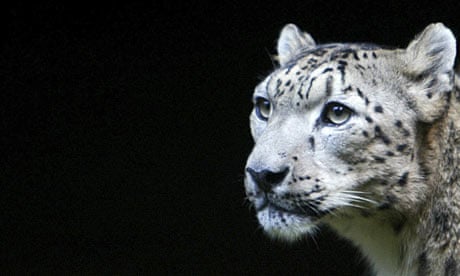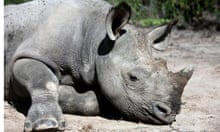For more than 10 years, Shafqat Hussain has been on the trail of the endangered snow leopard. He has heard the beast's growl, and has seen its pugmarks against a snowy track. But his dream, of coming eye-to-eye with the elusive nocturnal feline, remains unfulfilled. "If you've seen the cat, you've seen the Holy Grail," says Hussain.
However, he is not as much "driven by sighting the animal, as ensuring its survival", says the 41-year-old Hussain, an environmentalist and anthropology professor at Trinity College in the United States.
Snow leopards are globally "endangered", according to the International Union for Conservation of Nature's (IUCN) Red List of Threatened Species, with total population estimated at between 4,000 and 7,000.
While the Convention on International Trade in Endangered Species (CITES) bans the trade of snow leopards and its body parts, the wild feline – found only in the mountainous regions of central and south Asia – faces much antagonism from local herders who kill them in retaliation for attacks on their goats, Hussain says.
In 1999, Hussain started an innovative insurance programme in two Baltistan villages, named Project Snow Leopard, with funding from the Royal Geographical Society and the U.S.-based Snow Leopard Conservancy.
"I'm not totally indifferent to the loss the local community bears at the loss of their goats," Hussain told IPS in a telephone interview during his annual visit to Skardu – the capital town of Baltistan, a northern Pakistani region bordering Xinjiang, China.
His "alternate approach", Hussain explains, "helps in the conservation and protection of the snow leopards, but also compensates the local herders for every goat killed by the feline, on the condition that the villagers will not kill it".
Some six months ago, a snow leopard attacked Ghulam Mehdi's herd in Hushey village in Baltistan. "They (Project Snow Leopard) paid me a compensation of 4,500 rupees (52 U.S. dollars)," says Mehdi, a 35-year-old goat herder.
Mehdi has insured all his goats. "We pay two rupees (2 cents) per month for each goat. The project registers our livestock and keeps count," he says. "They only compensate if the goat has been killed by a leopard, not by a wolf or another wild animal. They can tell which animal has attacked our goats."
The key to the success of the programme – which has over 5,000 herders in it – is that the villagers own and run it. Residents have been trained to use and maintain remote cameras installed at various locations to monitor and study the snow leopard.
Project Snow Leopard has expanded to 10 Pakistani villages, and has been replicated in neighbouring countries like Nepal, China and India.
Indeed, "such programmes only succeed if the community is involved," says Ejaz Ahmad, the deputy director general of the World Wildlife Fund Pakistan. Similar programmes are underway for the common leopard in the resort towns of the Galiaath region of Khyber Pakhtunkhwa province.
"Over the years," he explains, "there is less and less reporting of the community involved in retaliatory killing of the both the species of the cats."
Humans are the biggest threat to the survival of snow leopards, found in the Himalayan mountain ranges in Afghanistan, China, India, Kyrgyzstan, Kazakhstan, Mongolia, Pakistan, Tajikistan and Uzbekistan. They have been spotted as far north as Siberia.
Weighing between 27 and 54 kilogrammes, the snow leopard can grow to lengths of up to 130 centimetres and sits at the top of the food chain. "One less species of the cat can cause the ecosystem to topple," says Hussain.
This can trigger environmental changes such as the denudation of vegetation cover, he explains. It can cause the population of wild goats to increase, which may lead to degradation of pastures that in turn causes soil erosion.
Based on a survey he conducted in 2003, Hussain estimates there are some 450 snow leopards left in Pakistan, spread across Chitral in the Gilgit-Baltistan territory; in the Dir, Swat, Kohistan districts of Khyber Pakhtunkhwa; and in Muzaffarabad in Pakistan-administered Kashmir.
"Its population grows, slowly," Hussain says, confident he will find improved figures when he carries out the next survey in 2013.
But snow leopards also continue to attack domesticated animals, though there is no scarcity of natural prey like the ibex and the markhor. "It's easier to kill a goat than stalking wild prey," explains Hussain.
Another reason for these attacks is the rapidly growing human population that is encroaching on the leopard's habitat. "But even that is not so much a concern as the attitude," Hussain points out. "There is a growing intolerance of the human race to let other species exist."
"The local people always held the view that the leopard was a threat that needed to be eliminated," Hussain says. "Over the centuries, with advancement in weapons, the negative slant has been transformed into negative action and thus its indiscriminate killing."
"There is a lot of pressure on the wild animals," acknowledges Ahmad of WWF. But he opines that it is not easy for the leopard to attack goats as herders take extra precautions. "The feline will only attack when its natural prey is unavailable and the cat is very hungry."
With a sprinkling of 212 villages across 50 percent of the snow leopard's habitat, Hussain acknowledges that his project has long way more to go. "Protecting and conserving animal species is the responsibility of the state," he says. "Hopefully we've provided a model to emulate."



Comments (…)
Sign in or create your Guardian account to join the discussion